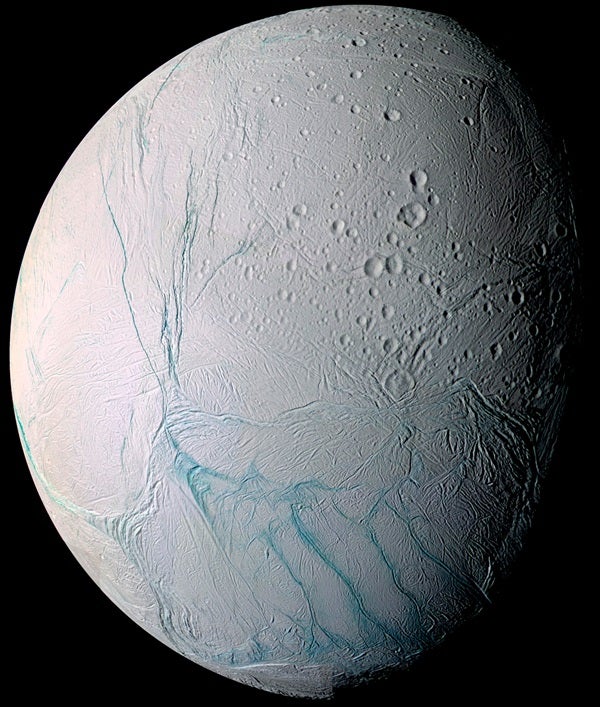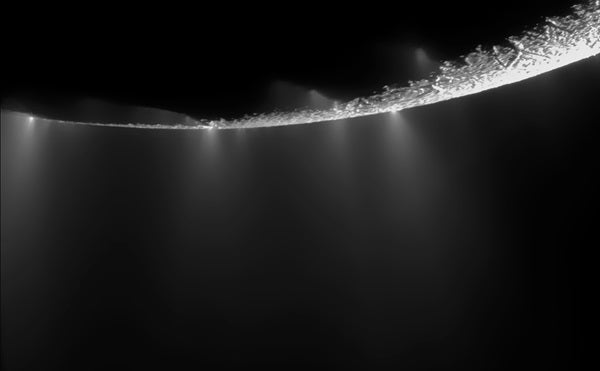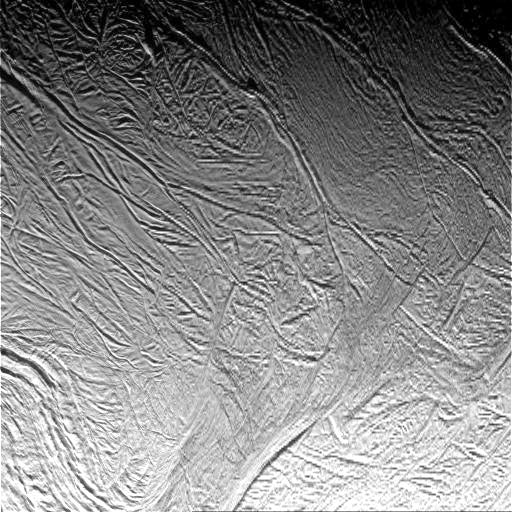In 1789, German-born British astronomer William Herschel discovered Saturn’s moon Enceladus, eight years after he amazed the world by finding the planet Uranus (see number 30 on our list). Just 310 miles (500 kilometers) in diameter, or one-seventh the width of our Moon, Enceladus remained a dot through telescopes until the early 1980s, when the twin Voyager spacecraft sped by with cameras clicking.
The Voyager probes revealed that the surface of Enceladus is largely water ice, pockmarked by intriguing features that soon received names dictated by the International Astronomical Union (IAU). Although Enceladus was a giant in Greek mythology, the IAU decreed its features must be named after characters and places from The Arabian Nights, and not just any translation, but Richard Francis Burton’s.
Voyager 2 photographed Enceladus’ craters, narrow valleys, and expanses of grooves and ridges. Sharp-edged canyons up to 120 miles (190km) long, 5 miles (8km) wide, and 0.5 mile (0.8km) deep fracture its surface and must be young and tectonic because they cut across other features. The craters were duly named after The Arabian Nights characters, while all other features are places in that literary epic. To date, 86 enceladusian locales have received official labels like “Aladdin Crater.”

Bringing the universe to your door. We’re excited to announce Astronomy magazine’s new Space and Beyond subscription box – a quarterly adventure, curated with an astronomy-themed collection in every box. Learn More >>.
The Voyager spacecraft showed that Enceladus orbits not near but actually in the densest part of Saturn’s then newly found E ring, which encircles the two bright (and one fainter) rings readily seen through earthly telescopes. The E ring is extremely diffuse and very wide. Mathematical analyses prove it should not last long — certainly less than a million years. Its continued existence means its materials are being replenished. Since the escape velocity of Enceladus is only about 500 mph (805 km/h) (compared to Earth’s 25,100 mph [40,300 km/h]), astronomers thought that violent meteor impacts on this moon must periodically throw up enough material to feed the ring.
A more persuasive mechanism for ring replenishment came to light in 2005 when the Cassini probe skimmed above Enceladus several times and uncovered a major bombshell — a geyser erupting from its south polar region. Previously, astronomers knew of three bodies in the universe with active volcanoes: Earth, Jupiter’s moon Io (see number 34 on our list), and Neptune’s moon Triton (see entry 16). Yet here was a fourth, but with a big difference. These eruptions don’t consist of glowing-hot material, but instead of cold-slurpee stuff — mostly water vapor and ice particles — blasted 300 miles (480km) into space, nearly the width of Enceladus itself, in powerful demonstrations of cryovolcanism.
But what was the source of these geysers, and the heat that could make them possible? Such a small moon surely couldn’t have an Earth-like molten center.
Enceladus lacks the extreme tidal stretching of Io, pulled like taffy by nearby massive Jupiter. Enceladus is the 14th most distant moon from Saturn, counting outward from the planet’s cloud tops. At a distance from Saturn’s center of 148,000 miles (238,000km), Enceladus orbits in just 32.9 Earth hours, precisely twice the time it takes the inner satellite Mimas to make one circuit. Thus, it meets Mimas every other revolution. Enceladus also has a 2:1 orbital resonance with outer Dione, so it regularly meets that moon, too. Such resonances create tidal stresses — forces that push and pull the satellite’s surface — that can indeed translate into a toasty interior.
The volcanic geysers obviously originate from subsurface water, making Enceladus only the second place in the universe, after Jupiter’s moon Europa, where copious pools of unseen liquid water lurk tantalizingly — with all the significant biological implications this carries with it.
Since its arrival at the Saturn system, the Cassini spacecraft has performed 19 flybys of Enceladus, including one that whooshed within a mere 32 miles (51 km) in 2010. Cassini actually flew through the geysers’ vented ejecta in 2005, so that its Ion and Neutral Mass Spectrometer and Cosmic Dust Analyzer sampled the material. Result? It’s mostly water along with small amounts of nitrogen, methane, carbon dioxide, solid particles, and even ammonia. The 2008 flyby detected more trace chemicals that included hydrocarbons like propane, ethane, and acetylene, which altogether resembles the makeup of comets, except here the milieu is much warmer.
In 2009, researchers analyzing the material from these geysers concluded that the subsurface liquid of Enceladus is essentially salt water. It may either be pooled in separate large caverns, or, more likely, in vast lakes or oceans. This is a matrix that can support life.
Then in 2011, astronomers found an electrical current of high-intensity electrons continuously surging between Enceladus and Saturn. This interchange even creates an aurora on the ringed planet. This moon sparks and snaps with a dynamic energy far beyond what Herschel could have ever dreamt.
And the world has only gotten more intriguing in the past two years. In 2014, new Cassini gravity measurements suggest that Enceladus’ subsurface water is a large, possibly regional, ocean about 6 miles (10km) deep beneath an ice shell about 19 to 25 miles (30 to 40 km) thick. And studies in 2015 reveal that some of those intriguing geysers may instead be curtain eruptions along the entire length of the “tiger stripe” fissures on Enceladus’ surface. They only appear like sporadic geyser-like jets because of Cassini’s viewing angle.
Add this to its odd location within a ring, its violently erupting vents of water in various states, and its strong potential for life, and you can see why Enceladus is a standout among smaller worlds in the universe. Not to mention that its status in NASA’s future exploratory wish list is now suddenly elevated, big-time.












